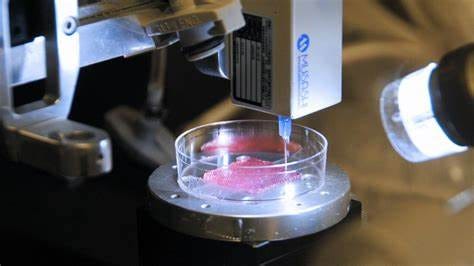Bioprinting
Written by Sai Koppada
In our rapidly advancing world, technology has pushed medicine beyond countless boundaries and created numerous opportunities for more efficient and effective health care. One of its most fascinating advancements is Bioprinting or the use of 3-D printing technology to create biological structures that mimic the human body parts.
3-D printing is traditionally used for a variety of things from creating toy models to printing houses. In the medical field, it is used to create parts for prosthetics, models, and implants. Using the same principle, 3-D printing can be used to create organs for patients from biological materials. Though the process is still in its research and development stage, it has the potential to allow doctors to create organs from biological materials such as cells and tissue known as bio inks. If this type of technology were to be accessible to healthcare providers, then it would help solve problems with organ availability for transplantation, issues with bone and skin grafting, and decrease the chances of the body rejecting the implant.
The process of bioprinting uses the cells and tissue from the patient or adult stem cells to print organs that are more compatible with the patient’s body. This has the potential to increase the biocompatibility between the printed organ and the patient, as the organ is made from the patient’s own tissue or stem cells that can easily adapt to the specific needs of the patient's body. This helps reduce the risk of the immune system viewing the transplant as a foreign object in the body and initiating an immune response against it. Bioprinting also allows the organ to be customized, since it allows healthcare professionals to carefully design and tailor the organ to fit the needs of the patient, increasing the compatibility. Similar to how 3-D printing can be used to custom make parts for a machine, healthcare workers can alter the size, shape, width, and many other factors of the organ as the machine uses bio links to replicate the blueprints that the doctors give it.
Bio inks are a combination of tissue and cells that function as filaments for building the organs, they’re typically harvested from the patient themselves or from adult stem cells to print the organ. These bio-inks also contain growth factors as well as other biological components that allow the printers to carefully layer materials to create the desired product. They help make sure that the printed organ will perform its function well and ensure that it’s a good fit for the patient.
So far, bioprinting has been used to replicate organs like bladders and to create skin and bone grafts. Researchers are also exploring the potential for bioprinting to produce a wider range of organs and even blood vessels. One day, it may have the ability to replicate every part of the body!
Though technology has many benefits, there are still complications associated with it such as the ethical implications regarding the cost and availability of bioprinting. Currently, we can't mass print organs for medical use and there are still technical problems with bioprinting such as ensuring that the organs created through this process are long-lasting and can draw nutrients from the body to essentially "stay alive." Additionally, we don’t have a method to harvest enough cells from the patient to create large yet and the technology needed for bioprinting still needs to undergo extensive research before it can be introduced to the general public.
Even though bioprinting still has to be improved before it can be introduced to the general public, it has significant potential to revolutionize transplantation and medicine as a whole.
Written by Sai Koppada from MEDILOQUY


